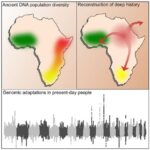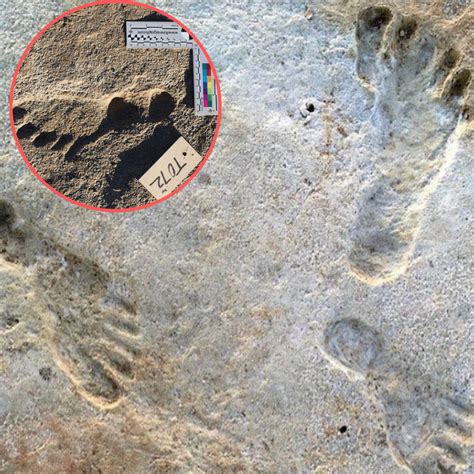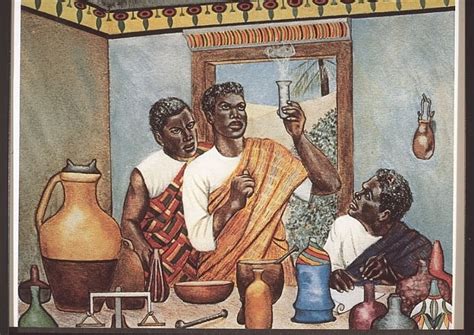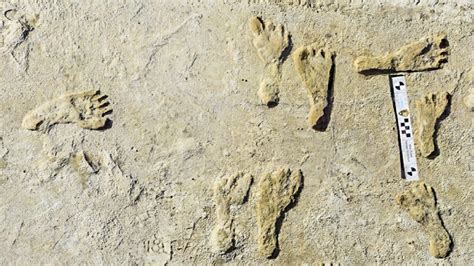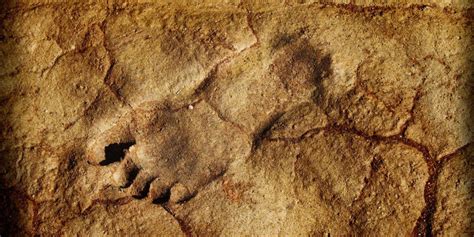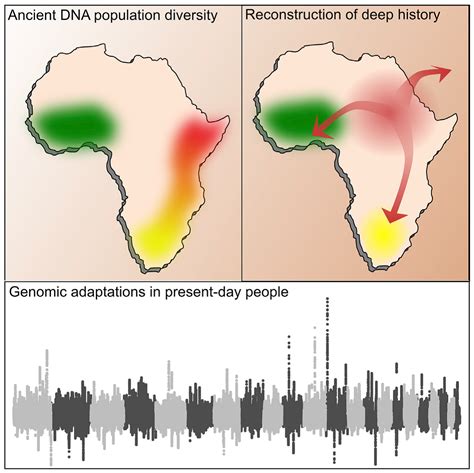
A groundbreaking DNA study has revealed a surprising and complex history of early human populations in Africa, indicating that groups once thought to be distinct actually mixed extensively, challenging previous assumptions about human evolution on the continent. The research, published in the journal Nature, unveils that ancient humans across different regions of Africa were more interconnected than previously believed, with significant gene flow occurring between eastern, southern, and western African populations. This intermingling reshapes the understanding of the development and diversification of human lineages, suggesting a more fluid and dynamic evolutionary narrative.
The study, led by researchers from the University of Pennsylvania and other institutions, analyzed newly obtained genetic data from ancient human remains found across Africa. These remains, dating back thousands of years, provided crucial insights into the genetic makeup of early populations and allowed scientists to trace the patterns of migration and interaction that shaped the continent’s human diversity. The findings contradict older models that portrayed a more isolated evolution of regional groups, suggesting that Africa’s ancient inhabitants were part of a larger, interconnected network of communities.
“The story of early human evolution is more like a braided stream than a tree,” explained Dr. Sarah Tishkoff, a professor of genetics and biology at the University of Pennsylvania and one of the study’s lead authors. “Our research shows that there was a lot of gene flow between different groups, blurring the lines between what we once thought were distinct lineages.”
The team extracted DNA from the skeletal remains of individuals unearthed from various archaeological sites in Tanzania, Malawi, and South Africa. Advanced genomic techniques were then used to analyze the DNA and compare it with that of present-day African populations and other ancient human genomes. This comparative analysis allowed the researchers to identify specific genetic markers and trace the ancestry of different groups, revealing a complex web of relationships that spanned vast geographical distances.
One of the most significant findings was the evidence of substantial gene flow between eastern and southern African populations. Previous theories had posited that these groups evolved largely in isolation, with limited interaction. However, the new genetic data showed that there was significant intermingling between these populations, suggesting that they were part of a larger, more connected network of communities. This finding challenges the notion of discrete regional lineages and underscores the importance of considering the continent as a whole when studying human evolution.
Furthermore, the study also shed light on the relationship between these eastern and southern African populations and those in western Africa. While previous research had suggested a more distant connection between these regions, the new data revealed that there was also some degree of gene flow between them, indicating that the interconnectedness of ancient African populations extended even further than previously believed.
The implications of these findings are far-reaching, requiring a reevaluation of existing models of human evolution in Africa. The study highlights the need to consider the dynamic and interconnected nature of early human populations when studying their history and diversification. It also underscores the importance of preserving and studying ancient human remains, as they provide invaluable insights into the genetic makeup and evolutionary history of our species.
“These findings are really rewriting the history books,” said Dr. David Reich, a professor of genetics at Harvard Medical School, who was not involved in the study. “They show us that the story of human evolution in Africa is far more complex and nuanced than we ever thought.”
The research also raises new questions about the cultural and technological exchanges that may have accompanied the gene flow between different populations. As groups interacted and intermingled, they likely shared knowledge, skills, and technologies, contributing to the cultural diversity and innovation that characterized early human societies. Further research is needed to explore these connections and gain a deeper understanding of the complex interplay between genetic and cultural evolution.
The study also emphasizes the importance of continued research in this area, particularly the need to analyze additional ancient human remains from different regions of Africa. By expanding the dataset of ancient genomes, researchers can gain a more comprehensive understanding of the continent’s human evolutionary history and unravel the remaining mysteries of our origins.
The results of this study not only affect the scientific community but also have implications for how we understand human diversity and identity. By showing that ancient human populations were more interconnected than previously believed, the research challenges the notion of fixed and distinct racial categories. It highlights the common ancestry that unites all humans and underscores the importance of celebrating our shared heritage.
The research team plans to continue their work by analyzing additional ancient human remains from across Africa and exploring the connections between genetic and cultural evolution. They hope that their findings will inspire further research in this area and contribute to a more complete and nuanced understanding of our origins.
“This study is just the beginning,” said Dr. Tishkoff. “There is still so much more to learn about the history of human evolution in Africa. By continuing to study ancient DNA and combining it with archaeological and linguistic evidence, we can gain a much deeper understanding of our past.”
In-Depth Analysis and Context
The traditional view of human evolution in Africa has been largely shaped by the “Out of Africa” theory, which posits that modern humans originated in Africa and then migrated to other parts of the world. However, this theory has often been interpreted as implying a relatively simple and linear progression of human evolution, with distinct lineages evolving in isolation before eventually spreading out across the globe.
The new DNA study challenges this simplistic view by revealing that the evolutionary history of humans in Africa was far more complex and dynamic. The evidence of extensive gene flow between different populations suggests that there was a constant exchange of genetic material and cultural ideas across the continent, blurring the lines between what were once thought to be distinct regional lineages.
This interconnectedness may have been facilitated by a number of factors, including trade networks, migration patterns, and cultural exchange. As different groups came into contact with one another, they not only exchanged genes but also shared knowledge, skills, and technologies. This process of cultural diffusion may have played a crucial role in the development and diversification of early human societies.
One of the most intriguing aspects of the study is the evidence of gene flow between eastern and southern African populations. These regions are geographically distant and ecologically diverse, which may have led to the assumption that they evolved in relative isolation. However, the new genetic data shows that there was significant intermingling between these populations, suggesting that they were part of a larger, more connected network of communities.
This finding raises new questions about the nature of this connection. What factors facilitated the movement of people and genes between these regions? Was it driven by trade, migration, or some other form of interaction? Further research is needed to explore these questions and gain a deeper understanding of the relationship between eastern and southern African populations.
The study also sheds light on the relationship between these eastern and southern African populations and those in western Africa. While previous research had suggested a more distant connection between these regions, the new data reveals that there was also some degree of gene flow between them. This finding suggests that the interconnectedness of ancient African populations extended even further than previously believed, encompassing a vast network of communities that spanned the entire continent.
The implications of these findings are far-reaching, requiring a reevaluation of existing models of human evolution in Africa. The study highlights the need to consider the dynamic and interconnected nature of early human populations when studying their history and diversification. It also underscores the importance of preserving and studying ancient human remains, as they provide invaluable insights into the genetic makeup and evolutionary history of our species.
The research also raises new questions about the cultural and technological exchanges that may have accompanied the gene flow between different populations. As groups interacted and intermingled, they likely shared knowledge, skills, and technologies, contributing to the cultural diversity and innovation that characterized early human societies. Further research is needed to explore these connections and gain a deeper understanding of the complex interplay between genetic and cultural evolution.
The Significance of Ancient DNA
The ability to extract and analyze DNA from ancient human remains has revolutionized the field of human evolution. Ancient DNA provides a direct window into the genetic makeup of past populations, allowing scientists to trace their ancestry, identify genetic markers, and reconstruct their evolutionary history.
Prior to the advent of ancient DNA technology, researchers relied primarily on archaeological evidence and comparative anatomy to study human evolution. While these methods provided valuable insights, they were limited in their ability to reveal the genetic relationships between different populations.
Ancient DNA analysis has overcome these limitations by providing a direct source of genetic information from the past. By comparing the DNA of ancient individuals with that of present-day populations, researchers can identify specific genetic markers that are shared between them, allowing them to trace the ancestry of different groups and reconstruct their evolutionary history.
The study of ancient DNA is not without its challenges. DNA degrades over time, making it difficult to extract and analyze from ancient remains. In addition, contamination from modern DNA can also be a problem, particularly in cases where the remains have been handled by multiple individuals.
Despite these challenges, advances in ancient DNA technology have made it possible to extract and analyze DNA from increasingly ancient remains. These advances have opened up new avenues of research and have led to a wealth of new discoveries about human evolution.
Challenges to Previous Theories
This new study directly challenges some long-held assumptions about human evolution in Africa. The traditional view often presented a model where different regional groups evolved relatively independently, with limited interaction. This study demonstrates that there was significant gene flow across vast distances, suggesting a much more interconnected network of early human populations.
One example of a challenged theory is the idea that eastern and southern African populations evolved largely in isolation. The study’s findings of substantial gene flow between these regions refute this idea, suggesting instead that these populations were part of a larger, interconnected network of communities. This intermingling challenges the notion of discrete regional lineages and underscores the importance of considering the continent as a whole when studying human evolution.
Furthermore, the study’s evidence of gene flow between western Africa and eastern/southern Africa further complicates the traditional narrative. Previous research had suggested a more distant connection between these regions, but the new data reveals that the interconnectedness of ancient African populations extended even further than previously believed.
These challenges to previous theories highlight the importance of continuously reevaluating our understanding of human evolution as new data and technologies become available. The study serves as a reminder that our understanding of the past is constantly evolving and that new discoveries can often overturn long-held assumptions.
Impact on Understanding Human Diversity
The findings of this study have significant implications for how we understand human diversity. By showing that ancient human populations were more interconnected than previously believed, the research challenges the notion of fixed and distinct racial categories. It highlights the common ancestry that unites all humans and underscores the importance of celebrating our shared heritage.
The study also emphasizes the importance of considering the dynamic and interconnected nature of early human populations when studying their history and diversification. It suggests that human diversity is not simply the result of isolated evolution in different regions, but rather the product of a complex interplay of genetic and cultural exchange.
By challenging the notion of fixed racial categories, the study has the potential to promote greater understanding and tolerance between different groups. It highlights the fact that all humans share a common ancestry and that our differences are relatively superficial compared to our shared heritage.
Future Research Directions
The study also opens up new avenues for future research. One area of focus will be to analyze additional ancient human remains from different regions of Africa. By expanding the dataset of ancient genomes, researchers can gain a more comprehensive understanding of the continent’s human evolutionary history and unravel the remaining mysteries of our origins.
Another area of focus will be to explore the connections between genetic and cultural evolution. As groups interacted and intermingled, they likely shared knowledge, skills, and technologies, contributing to the cultural diversity and innovation that characterized early human societies. Further research is needed to explore these connections and gain a deeper understanding of the complex interplay between genetic and cultural evolution.
Researchers also plan to investigate the environmental factors that may have influenced the migration and interaction of different populations. Climate change, resource availability, and other environmental factors may have played a significant role in shaping the patterns of human evolution in Africa.
By pursuing these and other research directions, scientists hope to gain a more complete and nuanced understanding of our origins and the forces that have shaped human diversity.
FAQ: Ancient African Humans and DNA Study
-
What is the main finding of this new DNA study on ancient African humans?
The study reveals that ancient human populations in Africa were more interconnected than previously thought, with significant gene flow occurring between eastern, southern, and western African groups. This challenges the idea of isolated regional evolution and suggests a more dynamic and complex history of human development on the continent.
-
How did researchers conduct this study?
Researchers extracted DNA from ancient human remains found in Tanzania, Malawi, and South Africa. They analyzed this DNA using advanced genomic techniques and compared it with the DNA of present-day African populations and other ancient human genomes to trace ancestry and identify patterns of migration and interaction.
-
What does “gene flow” mean in the context of this study?
Gene flow refers to the transfer of genetic material between different populations. In this study, the evidence of gene flow indicates that different groups of ancient Africans intermingled and reproduced, leading to a sharing of genetic traits across regions. This suggests that populations were not as isolated as previously believed.
-
How does this study challenge the “Out of Africa” theory?
While the study doesn’t refute the “Out of Africa” theory, which states that modern humans originated in Africa, it complicates the narrative by showing that the evolution within Africa was not a simple, linear progression. The study suggests that there was significant intermingling and interaction among different African populations before they migrated to other parts of the world, making the pre-migration history more complex.
-
What are the implications of this study for understanding human diversity today?
The study suggests that human diversity is the result of complex interactions and gene flow among different populations throughout history. It challenges the idea of fixed racial categories and emphasizes the common ancestry that unites all humans. It suggests that differences between groups are relatively superficial compared to our shared genetic heritage.
-
Where were the ancient human remains found that were used in the study?
The skeletal remains were unearthed from various archaeological sites in Tanzania, Malawi, and South Africa. These locations provided a geographically diverse sample of ancient human populations from different regions of Africa.
-
What is the significance of studying ancient DNA?
Ancient DNA provides a direct window into the genetic makeup of past populations. It allows scientists to trace ancestry, identify genetic markers, and reconstruct evolutionary history in a way that is not possible with archaeological evidence or comparative anatomy alone.
-
What were some of the previous assumptions about the evolution of humans in Africa that this study challenges?
Previously, it was often assumed that different regional groups in Africa evolved relatively independently, with limited interaction. This study challenges that assumption by demonstrating significant gene flow across vast distances, suggesting a more interconnected network of early human populations.
-
What factors might have facilitated the gene flow between different populations in ancient Africa?
Possible factors include trade networks, migration patterns, and cultural exchange. As different groups came into contact, they exchanged genes, knowledge, skills, and technologies, leading to greater interconnectedness.
-
How does this study impact our understanding of race and human identity?
By showing that ancient human populations were more interconnected than previously believed, the research challenges the notion of fixed and distinct racial categories. It highlights the common ancestry that unites all humans and underscores the importance of celebrating our shared heritage.
-
What are the next steps for researchers in this field?
Future research directions include analyzing additional ancient human remains from different regions of Africa, exploring the connections between genetic and cultural evolution, and investigating the environmental factors that may have influenced the migration and interaction of different populations.
-
How does the study support or contradict the “single origin” hypothesis of human evolution?
The study generally supports the “single origin” or “Out of Africa” hypothesis, which posits that modern humans originated in Africa and subsequently migrated to other parts of the world. However, it adds a layer of complexity by showing that the evolutionary history within Africa was not a simple, linear process but rather involved significant intermingling and gene flow among different populations.
-
What type of genetic analysis was performed in this study?
The researchers used advanced genomic techniques to analyze the DNA extracted from the ancient human remains. This involved sequencing the DNA, identifying genetic markers, and comparing the genetic profiles of different individuals and populations.
-
Why is it important to preserve and study ancient human remains?
Ancient human remains provide invaluable insights into the genetic makeup and evolutionary history of our species. They offer a direct record of the past, allowing scientists to trace ancestry, identify genetic markers, and reconstruct the relationships between different populations.
-
How does this study contribute to our understanding of early human behavior and culture?
By revealing the interconnectedness of ancient African populations, the study suggests that there was likely a significant exchange of knowledge, skills, and technologies between different groups. This implies a dynamic and interconnected cultural landscape in ancient Africa, where ideas and innovations spread across vast distances.
-
Are the findings of this study conclusive, or could they change with future research?
While the findings of this study are significant and based on rigorous analysis of ancient DNA, they are not necessarily conclusive. As with any scientific research, new data and technologies could lead to revisions or refinements of our understanding of human evolution in Africa.
-
How does the environment of Africa have influenced human development and diversity, according to the study?
The study doesn’t directly address specific environmental influences. However, it implies that factors such as climate change, resource availability, and geographical barriers could have played a role in shaping the patterns of human migration and interaction in Africa, which in turn influenced genetic diversity.
-
What role do archaeological discoveries play in conjunction with DNA research in understanding human history?
Archaeological discoveries provide the physical context for understanding human behavior and culture in the past. They can reveal information about tools, artifacts, settlements, and burial practices. When combined with DNA research, archaeological findings can provide a more complete and nuanced picture of human history.
-
How does the study address the concept of “race” in light of the findings of interconnectedness?
The study challenges the biological basis of race by demonstrating that ancient human populations were more interconnected than previously believed. It suggests that the concept of race as a fixed and distinct biological category is not supported by the genetic evidence and that all humans share a common ancestry.
-
What ethical considerations are involved in studying ancient human remains, and how are they addressed in this study?
Ethical considerations in studying ancient human remains include respecting the cultural and religious beliefs of descendant communities, obtaining informed consent, and ensuring that the research is conducted in a responsible and transparent manner. Researchers often collaborate with local communities and indigenous groups to ensure that their perspectives are taken into account. The study likely adhered to established ethical guidelines for the handling and analysis of ancient human remains.
-
How can we use the findings of this study to promote greater understanding and tolerance between different groups today?
By highlighting the common ancestry and interconnectedness of all humans, the study can help to challenge stereotypes and prejudices that are based on the idea of fixed and distinct racial categories. It can promote greater understanding and tolerance by emphasizing our shared heritage and the fact that our differences are relatively superficial compared to our shared genetic makeup.
-
What are some of the limitations of studying ancient DNA?
Limitations of studying ancient DNA include the degradation of DNA over time, the difficulty of extracting and analyzing DNA from ancient remains, and the risk of contamination from modern DNA. These challenges can make it difficult to obtain reliable and accurate genetic data from ancient samples.
-
How does this study contribute to the ongoing debate about the origins and dispersal of modern humans?
The study contributes to the ongoing debate by providing new evidence about the complex evolutionary history of humans within Africa. It suggests that the dispersal of modern humans out of Africa may have been preceded by significant intermingling and interaction among different populations, making the pre-migration history more complex than previously believed.
-
Can the information from this study be used to trace the ancestry of specific individuals or groups today?
While the study provides a broad overview of the genetic relationships among ancient African populations, it may not be possible to use the information to trace the ancestry of specific individuals or groups today. The genetic markers and patterns identified in the study are likely to be shared by many different populations, making it difficult to pinpoint the exact origins of any particular individual or group.
-
How does the study emphasize the importance of Africa in the story of human evolution?
The study reinforces the importance of Africa as the birthplace of modern humans and highlights the continent’s role as a center of genetic diversity and evolutionary innovation. It emphasizes that the story of human evolution is not simply a linear progression but rather a complex and dynamic process that has been shaped by interactions and gene flow among different populations in Africa.




